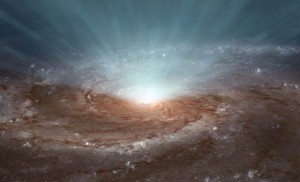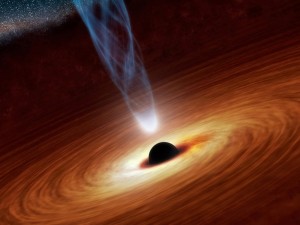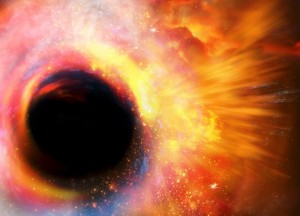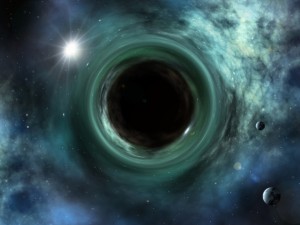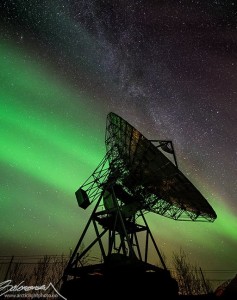The BBC Horizon program, Supermassive Black Holes, is an example of how science documentaries have turned science into science fiction, by combining a little science fact with fictional writing to produce speculative science fiction. Unfortunately, much of modern mainstream science is infected with this type of speculative fiction. We can lay the blame for this on the modern scientific method, which has deviated from the strict traditional approach, to become a Frankenstein Monster, where science has morphed into science fiction through the sensationalization of scientific discovery.
There is a lot of entertainment value in the program Supermassive Black Holes, and there may be just enough of a small dash of actual science to make the documentary a useful educational device for teenagers to learn about science. Unfortunately, if the goal is to inspire young brilliant minds to take up cosmology, this is not the best way to do that, since any young aspiring astronomer is soon going to realize that actual science is real work, and is not so exciting as this BBC documentary makes it appear to be. In the BBC documentary, scientific discovery seems to be everywhere and happening daily. The reality is however, something quite different than what is depicted in the BBC Horizon Program. That is because the program romanticizes the daily hard work of traditional science by taking the results of relatively unimportant measurements and glorifying them with bombastic language, hagiographic personality profiles, and literary embellishment. All to produce an effect that makes scientific discovery seem much more important than it actually is. In effect, the propaganda machine of science has turned normal science into an extraordinary fiction of scientific discovery. This may actually inspire some teenagers to become scientists, and actually help some interested laymen to understand what science is about, but as a documentary about real actual science the program is pretty disappointing.
The main character in this fictional story is the supermassive black hole. However although it is the main character in the story, we are not informed as to what a black hole actually is, so that we might actually find out who this strange character really is. Instead we are introduced to a Frankenstein Monster. There is a lot of fiction surrounding the black hole, and to be honest it has been around for so long that it is no longer capable of inspiring the awe and fear that it once was capable of. Years ago, in 1979, Walt Disney produced a science fiction film “The Black Hole”. It is classic science fiction, and its tag line tells us that, it is “A story of robots and humanoids, human genius and madness, and a spectacular descent into nature’s ultimate mystery – The Black Hole.” This is basically the same story line that we find in the new documentary, Supermassive Black Holes. After nearly 40 years it is amazing that the same story line can be used, all that is different is that we make the main character bigger, more massive, more powerful, and more mysterious than ever.
The documentary is not very honest and transparent with the view regarding the history of black holes and the science behind them. They have been around for quite a long time and the truth of the matter is they are are mostly a fictional invention of modern science. It turns out that the plain vanilla old massive black hole created by stellar collapse has lost a lot of its mystery and illustrious ability to command our interest. The main problem was that the universe should be full of black holes. However, after years of looking astronomers could not find a single one. That must have been pretty disappointing, particularly because some pretty famous cosmologists built their reputations on the study and popularization of black holes. The most famous is Stephen Hawking, who today is revered as much as Issac Newton, and Albert Einstein. Unfortunately, no one was able to actually prove that they had observed a black hole. Such an event would be considered a momentous discovery. The difficulties however were really great and the biggest one is that black holes are controversial, because they are more an invention of science than something that exists in the real world.
In February 2014 Stephen Hawking, who built his reputation studying the theory of black holes, declared that: “there are no black holes“. While many mainstream scientists were quick to reinterpret what Stephen said, so that the mainstream physics could be saved from his heresy, it remains that black holes are as controversial as ever, even though the BBC Horizon program has declared them to be science fact. More recently in August 2014, a physicist at the University Of North Carolina, Laura Mersini-Houghton has published a paper in which it is demonstrated by computer simulations that it is impossible for black holes to form and thereby supports Hawking’s claim that there are no black holes, because the theory of physics that was used to predict them was incorrect. Here the controversy hinges upon the Black Hole War. That controversy involved Stephen Hawking’s claim that information would be destroyed by black holes. At the time the controversy was resolved by the solution that both sides of the argument were correct. It seems that this resolution has not stood the test of time.
However, there is a much bigger problem for followers of mainstream science who believe that black holes exist. Expert cosmologist Professor G. C. McVittie says it this way, “GR black holes occur in certain highly-specialized exact solutions of Einstein’s field equations and so far only solutions containing a single centrally placed black hole are known. There is, therefore, no way of asserting through some analogy with Newtonian gravitational theory that a black hole could be a component of a close binary system or that two black holes could collide. An existence theorem would first be needed to show that Einstein’s field equations contained solutions which described such configurations.”
Needless to say no such existence theorem has ever been proven and published. Despite this rather conclusive disproof of the existence of black holes in theory, the BBC Horizon program ends with statements saying the following: “NARRATOR: At the moment Andromeda is moving towards us at 400,000 kilometres per hour and scientists think one day it will hit us. So Dubinski decided to work out what’ll happen to us in 3 billion years, when the two galaxies finally collide. After a long and complex calculation the result was a vivid picture of the impending collision. A detailed prediction of how the Milky Way will end. JOHN DUBINSKI: The clouds of gas hit each other at these huge velocities, hundreds of kilometres per second, and that basically creates great shockwaves which move through the gas and heat it to great temperature. NARRATOR: At the heart of this maelstrom the boiling gas is hurled towards the two converging black holes. This kick-starts a violent dual feeding frenzy as the two monsters spiral towards each other. JOHN DUBINSKI: And eventually those two independent black holes with their accretion discs will spiral together and merge themselves and form an even more massive black hole.” Since there is no existence theorem for two black holes to exist in the same space-time, as cited by McVittie, this rather over hyped catastrophe at the end of the BBC Horizon program is obviously just science fiction.
What Professor McVittie did not say in his 1978 paper was that the solution of Einstein’s field equations for the single black hole contained assumptions that came to be challenged in a series of papers by Leonard S. Abrams in 1989 and 1996. This produced a dispute which is clearly explained in the following: “Note that General Relativity and Einstein’s field equations do NOT actually directly predict the existence or otherwise of black holes, contrary to popular opinion. In the solutions of those equations described by the Schwarzschild solution and later extensions such as the Kerr solution for rotating central bodies, the radial coordinate involves a constant of integration which is determined by assumed boundary conditions. Karl Schwarzschild himself derived his solution using a Euclidean radial coordinate, making the assumption that a point mass was located at the origin, but then pointed out that the mathematics for describing the solution could be simplified by using a different radial coordinate, which had a value of 2GM at the physical origin. (See arXiv:physics/9905030 for a translation of Schwarzschild’s original paper). When Hilbert later described Schwarzschild’s solution, he did it directly in terms of the simplified radial coordinate system, but assumed that the physical origin was where Schwarzschild’s modified radial coordinate was zero rather than 2GM.”
“It is this assumption from Hilbert which gives rise to the possibility of black holes, and for a long time it seems that no-one noticed that any assumption had been made, until Leonard S Abrams dared to point this out in 1989 (arXiv:gr-qc/0102055). Unfortunately, as there doesn’t seem to be any obvious way to prove which boundary assumption is better, this has given rise to various surprisingly fierce battles based on somewhat unsatisfactory arguments which appear to boil down to “my assumptions are better than your assumptions”. My personal opinion at present, on the grounds of simplicity, is that Schwarzschild’s assumption makes a lot more sense than Hilbert’s, in which case black holes don’t happen, although it’s difficult to distinguish an exceedingly dense object which hasn’t quite collapsed into a black hole from one which has. Experimental evidence suggests that at least some extremely dense objects involved in quasars have strong intrinsic magnetic fields, which means they cannot be black holes because of what is known as the “no hair” theorem, and this supports Schwarzschild’s original assumption. “
To repeat, there are scientists who can prove that the mathematics of the black hole is erroneous and false. In particular, the mathematics of black holes is such that if one exists, the mathematics shows that nothing else can exist in the universe. That is because the mathematics uses an idealization. The idealization is such that the equations of general relativity only have solutions that produce the existence of a one and only one black hole and nothing else, such that the black hole is the only thing that exists in the entire universe. In other words, if a black hole exists, nothing else is allowed to exist, because the black hole is the only thing that exists in the mathematical solution of general relativity. Hence, the black hole is an idealization that can exist only if the remainder of the universe does not exist. That is because if a black hole actually existed, the rest of the universe doesn’t exist. They are mutually exclusive. Because the black hole only exists in the idealized world of a highly improbably mathematical solution, many experts think that the existence of black holes is a fiction and so they don’t really exist. Hence it is a surprise to hear that someone claims to have discovered supermassive black holes and proved that they actually exist. The fact that something that is a mathematical idealization, invented out of mathematics by pure human invention comes therefore as a surprise and a shock to anyone really informed about the mathematical theory that predicts they should exist.
The problem with special relativity is that it forms the basis for the claim that space-time exists and that in the realm of space-time, space is contracted and time is dilated. There is however, no proof that either of these things actually happen. There is no proof of any kind of contraction of space, and so any theory that is based upon this idea, such as general relativity ought to be approached with a large bit of skepticism. Particularly when the theory predicts an extreme warping of space as is claimed to happen in a black hole. In special relativity we have a good example of how the scientific method becomes science fiction, through a lack of rigorous and logical scientific method. The method goes this way. Experiments are claimed to prove that special relativity is correct, then when mathematical arguments are produced that prove that special relativity is false, these same experiments are used to claim that the proofs that special relativity is false are themselves false. This is a tautology and false scientific method. The rigorous method works by verifying or validating that the mathematics works for a particular case, and not by proving that mathematics is incorrect. You can not use experiments to say that a mathematical proof is false, only that a mathematical argument might be correct, assuming that its axioms are valid and that it is logically consistent. If you produce a proof that the mathematics is false, it is not correct procedure to say that is false because experiments have proved the refuted mathematics is correct. That is equivalent to saying that empirical science can disprove valid mathematics. That is simply bad science.
In review of the film, the first point to ponder is that it is not at all clear what the film purports to be about. There are tow basic claims. One is the discovery of supermassive black holes at the center or nucleus of all galaxies and the other is the claim of a relationship between the mass of this black hole and the size of the galaxy. The first claimed discovery is nothing new since, the idea that there is some supermassive object at the nuclei of galaxies has been around since at least the 1960s. So the only new result is the relationship between black hole mass and galaxy size. That is certainly not a spectacular discovery. However, the viewer is confused as to the significance of this result by all of the hype and fictionalization of the supermassive black hole. One conclusion is that there is no proof that they discovered a supermassive black hole, that is just a fictional claim based upon the romance and hype of black holes. The problem is that as good science, the claim is faulty since the theory upon which the fiction of black holes is founded is full of holes and the existence of black holes as real objects in the universe is doubtful. There is no actual proof that they exists in theory and so to claim that one has discovered a black hole, never mind a supermassive one, is just a lot of hype to gain publicity. Black holes are little more than science fiction. Although very good science fiction, they don’t make good science fact since there is no way to prove that something that is an invention of a flawed, contested, and controversial theory actually exists.
To summarize, the conclusion that there exist such things as supermassive black holes, is a conclusion that is based upon what mainstream science claims to be true. Unfortunately, it appears that there is absolutely no valid reason for insisting such a thing is true or even valid science. What the astronomers actually have done is observe relationships. Curiously, what they observed was not what was predicted, in that the prediction was made for active galaxies and it was not observed in them but was observed where it was not predicted to be. So we have a misuse of scientific method. To be a rigorous, correct, and proper use of scientific method we have to fulfill a number of requirements. In the first place we have to have a clearly correct theory from which to make predictions. That does not exist because there is no conclusive proof that special relativity is valid. Since general relativity is based upon special relativity , we start from an uncertain foundation. Next we have the problem that general relativity is not the only possible theory of space-time that could be correct. Mainstream science assumes that it is the only possible theory, which is false because there is the much improved geometry of Cartan which is not the basis of general relativity. Then we have the problem that there is a controversy within mainstream science in that there is a contradiction between general relativity and quantum mechanics. This is the substance of the Black Hole War which seems to have resumed after an armistice. Finally, we have the crux of the problem which is the poorly defined criteria of proof in modern science. here, it is claimed that the proof that black holes exists, and thereby confirming the theory, is the existence of supermassive black holes. This is a tautology, because the claim that what is observed is a supermassive black hole is based upon the theory that predicts it, and the proof that the theory that makes the predictions is that the supermassive black holes have actually been discovered. Hence the proof that supermassive black holes exists, is dependent is a self referencing tautology and bad scientific method. So what we think of as valid science is really science fiction. That is scientists invent ideas and use fictions to claim that these ideas are actually something that we ought to accept as absolute truth.
The bottom line is that what the astronomers in the BBC Horizon show have discovered is that stars move very rapidly in the nuclei of galaxies and that there is a correlation between the supposed mass in the nuclei and the velocity of stars at the outer limits of the galaxy. Based upon this, it is possible to suppose that there could be such a thing as a supermassive black hole at the nucleus, and use that to make galaxy formation theories. However, based upon recent theoretical results, it seems that the formation of supermassive black holes might not be predicted by the general relativity theory. In addition, there may be other theories that are more accurate than general relativity and so we ought not to hang our hats on general relativity and the conclusion that supermassive black holes exist.
To end this review, the following statement by Stephen Crothers sums up this reviewers opinion: ” Contemporary physics has declined into a business, far from science. Demonstrably false and fantastic claims sell books, films and magazines, and can be used to misappropriate public funds. Tell a lie often enough and it becomes the truth. A typical example is the black hole, a purely mathematical abstraction for which no experimental evidence has been or could ever be found. The public do not really know what this thing is.”
![]()


